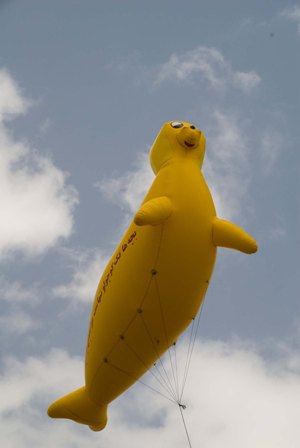Caspian seal project in Iran - activities and progress
2006
Following the Darwin project inception workshop in September 2006, the Iranian team immediately started to work to monitor seal mortality along the Iranian coast and to raise awareness of the plight of the Caspian seal among fishing communities. During the Ecotox project in 2000–02, Hormoz Asadi had surveyed and examined dead seals along the length of the Iranian Caspian coastline, and had estimated that about 500 seals died every year in fishing operations. The largest number of these seals were trapped in encircling nets in shallow water, and were then killed by fishermen when they brought their nets ashore. Seals seen near kilka (sprat) fishing operations were harpooned, as were seals near illegal gill net fishing nets. Some seals also drowned in bottom-set sturgeon nets.
The project team held workshops in two of the three coastal provinces of Iran (Guilan and Mazandaran). One of the most important outcomes of the workshops was an agreement with the Pareh (encircling) net fishermen in Guilan, who agreed to hold seals in a tank instead of killing them, for a fee of c. $30. The research team would then visit the seal, take blood and other samples for health screening, and then release the seal unharmed.
All this work was co-funded by a grant from the Caspian Environment Programme GEFII fund as well as by the Darwin project.
A tremendous step forward for the project was the agreement between the Darwin project, the Departments of Fisheries and Environment and the University of Guilan, to establish a Seal Centre in the coastal town of Bandar Anzali, in Guilan province. The Department of Fisheries agreed to provide the office space.
{docs}cepiranreportdec06{/docs}
2007
This season the workshops caried out last year were continued into Iran's 3rd coastal province, Golestan, with great success - fishermen here also agreeing that instead of killing seals caught in their pareh (encircling) nets, they would, for a small fee, hold seals temporarily for the seal team to examine and then release them unharmed. Great progress was also made with illegal fishermen, who - together with the seal team - drafted an agreement whereby the fishermen would obtain permission to fish legally in return for cooperating with the seal team's research and agreeing not to kill seals. This work was again partly co-funded by a small-grants fund from the GEFII project.

A seal festival was held in Guilan Province in August 2007 (see News Report in Front Page). The Darwin seal project team in Iran, together with the Caspian Environment Programme organised the event which found a large and enthusiastic crowd of children and adults all coming together under a flying seal balloon (donated by CEP). Children rode on floats, payed with seal toys, made model seals out of clay and heard speeches made by Dr Hamid Ghaffarzadeh of the CEP and Dr Hormoz Asadi of the Darwin Caspian seal team.
Meanwhile, further progress was made with the Seal Centre. The interior is now completed and ready for use as both a field and education centre. Simon Goodman and Sue Wilson were able to visit the Centre on their first visit to Iran in May 2007.
{docs}sealfisheriesreportiran1207{/docs}
2008
The seal project in Iran was thrown into turmoil in January, with the tragic death of the project leader, Dr Hormoz Asadi, in January. During the course of the year, the Darwin project has been adopted by the NGO, the Plan for Land Society. Plan for Land has been extremely active in re-establishing all the existing agreements with the Government Fisheries and Environment Departments. The team held a workshop for graduates in marine biology and Environmental sciences in Tehran on September 3rd to discuss and assess threats to the Caspian seal. Now (October 2008), the team is ready to start beach monitoring during the forthcoming fishing season. The Seal Centre was formally opened in the Spring, 2008.
{docs}plan4landeducationworkshop030908{/docs}
